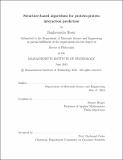Structure-based algorithms for protein-protein interaction prediction
Author(s)
Hosur, Raghavendra
DownloadFull printable version (13.23Mb)
Other Contributors
Massachusetts Institute of Technology. Dept. of Materials Science and Engineering.
Advisor
Bonnie Berger.
Terms of use
Metadata
Show full item recordAbstract
Protein-protein interactions (PPIs) play a central role in all biological processes. Akin to the complete sequencing of genomes, complete descriptions of interactomes is a fundamental step towards a deeper understanding of biological processes, and has a vast potential to impact systems biology, genomics, molecular biology and therapeutics. PPIs are critical in maintenance of cellular integrity, metabolism, transcription/ translation, and cell-cell communication. This thesis develops new methods that significantly advance our efforts at structure- based approaches to predict PPIs and boost confidence in emerging high-throughput (HTP) data. The aims of this thesis are, 1) to utilize physicochemical properties of protein interfaces to better predict the putative interacting regions and increase coverage of PPI prediction, 2) increase confidence in HTP datasets by identifying likely experimental errors, and 3) provide residue-level information that gives us insights into structure-function relationships in PPIs. Taken together, these methods will vastly expand our understanding of macromolecular networks. In this thesis, I introduce two computational approaches for structure-based proteinprotein interaction prediction: iWRAP and Coev2Net. iWRAP is an interface threading approach that utilizes biophysical properties specific to protein interfaces to improve PPI prediction. Unlike previous structure-based approaches that use single structures to make predictions, iWRAP first builds profiles that characterize the hydrophobic, electrostatic and structural properties specific to protein interfaces from multiple interface alignments. Compatibility with these profiles is used to predict the putative interface region between the two proteins. In addition to improved interface prediction, iWRAP provides better accuracy and close to 50% increase in coverage on genome-scale PPI prediction tasks. As an application, we effectively combine iWRAP with genomic data to identify novel cancer related genes involved in chromatin remodeling, nucleosome organization and ribonuclear complex assembly - processes known to be critical in cancer. Coev2Net addresses some of the limitations of iWRAP, and provides techniques to increase coverage and accuracy even further. Unlike earlier sequence and structure profiles, Coev2Net explicitly models long-distance correlations at protein interfaces. By formulating interface co-evolution as a high-dimensional sampling problem, we enrich sequence/structure profiles with artificial interacting homologus sequences for families which do not have known multiple interacting homologs. We build a spanning-tree based graphical model induced by the simulated sequences as our interface profile. Cross-validation results indicate that this approach is as good as previous methods at PPI prediction. We show that Coev2Net's predictions correlate with experimental observations and experimentally validate some of the high-confidence predictions. Furthermore, we demonstrate how analysis of the predicted interfaces together with human genomic variation data can help us understand the role of these mutations in disease and normal cells.
Description
Thesis (Ph. D.)--Massachusetts Institute of Technology, Dept. of Materials Science and Engineering, 2012. This electronic version was submitted by the student author. The certified thesis is available in the Institute Archives and Special Collections. Cataloged from student submitted PDF version of thesis. Includes bibliographical references (p. 109-124).
Date issued
2012Department
Massachusetts Institute of Technology. Department of Materials Science and EngineeringPublisher
Massachusetts Institute of Technology
Keywords
Materials Science and Engineering.